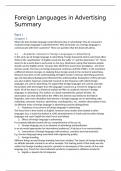Samenvatting
Full Summary for Foreign Languages in Advertising
- Instelling
- Radboud Universiteit Nijmegen (RU)
This is a full summary for the course Foreign Languages in Advertising from the study program International Business Communication at the Radboud University. It covers the whole book, and with that everything you need to know for the exam. With this summary I got a 9.7 on the exam.
[Meer zien]





